




France Travel Guide

🗝️ Key Facts
🏛️Capital: Paris
💶Currency: Euro €
🕙Time Zone: +1 GMT
📞Phone Code: +33
🌐Language: French
✈️Best time to visit: March-November
🍴Eat: Bakery pastries and crepes
🍷Drink: Champagne/ wine
🗺️Don't miss: The Eiffel Tower
🗺 Menu of Contents:
.jpg)
France is one of the world's top favourite destinations to travel to, in particular, Paris. There is no other travel destination on earth that has the romantic feel of France, so they say. Dreams of French holidays involve champagne on the Eiffel Tower, cruises on the Seine, bicycling through wine country and exploring the resorts of the Côte d'Azur.
A holiday in France offers a wide variety of attractions for all travellers, whether interested in culture and history or just having a good time. While Paris is famous for its sophistication, there are more than 40,000 castles and chateaus dotting the countryside, dozens of ski resorts in the French Alps, holiday towns along the coast, and countless cities and villages hidden around every hill providing never-ending opportunities to explore.
French culture is known for its effortless sophistication, including the gastronomic delights of French cuisine, museums dedicated to centuries of French art, and the creations of French fashion designers. Whether looking for a city break in Paris or exploring the lesser-known smaller towns, a holiday in France is the dream vacation for many.
France and it's capital, Paris, are one of the top tourism destinations worldwide. There are plenty of ways of getting to France, by air, road, trains and ships around Europe.
When coming from another continent, Air France is the national airline and provides links to every corner of the globe, from New York and Los Angeles to Buenos Aires, Tokyo or Singapore, just a few of the direct flights viable. If you are coming from Australia, New Zealand or other Pacific Islands you will need to make at least one stop. However, France is well connected by air to North America, Canada, The Caribbean, South America, The Middle East and Asia with daily links to most destinations.
For low cost travel within Europe, there are multiple airlines offering good fares when you book in advance; EasyJet, Ryanair, Vueling or Transavia are some for example.
France is situated in Western Europe, bordering Spain, Belgium, Luxembourg, Germany, Switzerland and Italy. It's no surprise that when travelling in Europe you can opt to drive around many of these countries and combine a multi city trip around France and the neighbouring countries.
Rail transportation is very reliable and comfortable and fast, thanks to the TGV, France High Speed Rail company. You can travel between many European capitals and Paris and main cities in France in just a few hours thanks to the TGV. There is also intercity trains as well as local trains serving smaller cities and towns, for them you don't need to book in advance but checking online for timetables and prices is always advised.
Busses are also a popular way of travelling in France and for those who don't drive, and want to visit smaller towns, busses are the ideal way of moving around. It's also possible to connect to international destinations around Europe with Eurolines.
Local transportation in France is advanced, modern and reliable. Big cities offer Metro systems, trams and local busses which are connected into one electronic paying system. There are multiple tickets or passes for those using the transport often, as well as weekly or monthly passes. (Check each city for more information regarding their transportation).
Despite France being a modern and safe country in Europe where crime rates are low, it is getting each time worse in big cities like Paris, Nice or Lyon.
With an increase of immigration and homeless people, it is advised that you always look out for your belongings and personal items such as cameras,wallets and mobile phones where pick-pocketing and robbery is on the increase!
Unfortunately when it comes to robberies, the police in Paris and big cities are very unhelpful and unable to speak in English in most cases. Make sure if something happens you ask for a report and don't get put off if they tell you to come back tomorrow as it's their duty to provide this service whatever the time. Find a "Commissaire" (French Police Station) to make this report.
❗Attention: Specially pay attention when travelling by public transport, on trains, metro and night busses which are easy for robbers and pickpockets to target tourists.
There are a lot of scammers and con-artists trying to take advantage of tourists, particularly in large cities and around major landmarks in Paris. Be aware of “gold ring” tricks, fake petitions, groups of teenagers acting strangely or trying to distract you, and people offering help with your luggage. Don't let people who are trying to ask you for help into covering your possessions, always hold on to bags and keep luggage in sight.
The climate of France is generally cold in winter and warm in summer, but mild winters and hot summers are usual along the Mediterranean sea (French riviera) and in the South West of France. Along the Rhône Valley a occasional strong, cold, dry, north-to-northwesterly wind blows known as the mistral. Lots of the snow falls in winter in the Mountainous regions like the Alps, Pyrenees and Auvergne. Temperatures can be well below freezing in this high areas, but if you stay in cities and lower grounds then Winter temperatures can range around 5-10 °C. In July and August it's the peak of summer and temperatures can reach easily in the high 30's °C. The best time to visit France is Spring or Autumn (March-June and September to November) to avoid the high season and enjoy pleasant temperatures to walk outside.
France is famous for producing some of the most sublime food in the world, whether it’s the speciality delicacies of high cuisine and award winning Michelin gourmet restaurants or the robust, village baking aromas from its traditional village boulangeries France has an almost unparalleled reputation for food. Many of the dairy products, specially cheese, together with wine and the famous Champagne have been categorised as national culinary and drink treasures and must tries. As well as the Baguette, (French Bread), Croissants, Soupe à l'Oignon Gratinée (Onion Soup), Croque-Monsieur (Ham and Cheese Sandwich), Quiche au Saumon et Crevettes (Salmon and Shrimp Quiche), Mousse au Chocolat (Chocolate Mousse) are a just a few of the tasty typical food you can find in France.
You can find the following specialities when visiting in France: Escargot, is a delicacy consisting of cooked land snails. Escargots are usually served as a starter in France. Bouillabaisse, fish stew, usually containing at least three or more,types of fish and shellfish. Cassoulet, (A Marseilles speciality) rich haricot bean casserole, often slow-cooked with various meats including duck, goose, and pork sausages. Quenelles de brochet, pounded pike formed into sausage shapes and usually served with a rich craysh sauce. Soué au Grand Marnier, traditional light dessert covered with orange liqueur. Bœuf bourguignon, a Burgundy dish of beef stewed in red wine. Raclette, melted cheese served with potatoes and meats. Ratatouille, (Popular in alpine areas in both France and Switzerland) a vegetable stew with ingredients commonly including aubergine, tomato, and courgette. Salade Niçoise, a salad originating from Nice, with tomato, tuna, and Niçoise olives. Crêpes, savoury, buckwheat versions are known as gallettes. Pastis, a popular aperitif.
As for drinks: Wine, the most popular alcoholic drink in France, from reds to whites and many grape specialities which have helped the country win many awards for it's fine wines. Calvados, an apple brandy made in Normandy. Champagne, this fizzy wine is just reserved for special occasions in France. It's common to drink it during birthday parties, inaugurations or end of year celebrations.
Source: Worldtravelguide.net
France was in fact the second foreign country I visited as a teenager and spent a 3 week interchange school programme in Lyon. Since then Paris is the only city I have visited and have been able to include it in these guides. Paris, can't be described as France as vice-versa. The country has changed a lot, specially socially in the big cities, where it is not uncommon to see large numbers of immigrant communities and a diverse multicultural society.
Paris is one of those cities where the "wow factor" is always present, watching the views from the Eiffel Tower, admiring the treasures from the Louvre Museum or walking to the top of the Sacre Coeur are all activities that makes you feel special about Paris. It's one of the oldest cities in Europe, and with a rich, historical and cultural background there is never a dull moment in Paris to keep yourself busy and entertained. For younger crowds, and Disney fans, it's also a heaven for going to Disneyland, combining your visit to the park with a few days tourism of Paris to make the most of your trip.
The downside of being such a popular city, the prices of accommodation, food and tourism in itself are very expensive and it's important you plan your visit with time and taking into consideration that peak times and the Summer season will mean lengthy queues to get into popular attractions and landmarks. Booking online is now essential if you want to guarantee your visit like the Eiffel Tower, Notre-Dame Cathedral or the Louvre amongst others.
Another aspect to consider is safety, although it's a secure city despite having had several terrorist attacks in the last years, Paris is full of scammers and people practising "pick-pocketing". Pay attention to your belongings and don't trust people who seem to suddenly need your help.
Despite the big cities, France, overall offers some incredible scenery and picturesque villages and towns which are the true essence of the French people. Take time to travel to the outskirts of the cities, the mountains and the coasts of France in the south, which are waiting to be discovered. I look forward to be able to recommend and write more about this beautiful country with many more cities and places to visit.
Paris Tourism Information Guide

Paris, France's capital, is a major European city and a global center for art, fashion, gastronomy and culture. Its 19th-century cityscape is crisscrossed by wide boulevards and the River Seine. Beyond such landmarks as the Eiffel Tower and the 12th-century, Gothic Notre-Dame cathedral. The city is known for its cafe culture and designer boutiques. It has drawn waves of immigrants, expatriate artists and intellectuals, and global traders for centuries, attracting by virtue of its vibrant economy, rich political and artistic history, many tourist sites, outstanding architecture and cultural life, and overall high standard of living. Visiting the city of Paris isn't cheap, but it's one of those cities with the "wow factor" present in so many ways! Planning your visit is essential, the times, season and your stay to be in good reach of transport. So come to Paris to enjoy the culture, the french flair, the monuments, the cuisine and the night life... there is a lot to keep you occupied!
The weather for Paris during the summer is usually hot and dry. This being the peak season as well, but it's more pleasant to visit Paris in the springtime or the Autumn to avoid the crowds. Additionally, the autumnal shades of trees lining the boulevards add a new dimension to the city's beauty.
Spring, from March to May, is the driest season in Paris but rainfall is distributed fairly evenly throughout the other seasons. It is best to have an umbrella with you in Paris no matter what the season, but the rain showers are usually as brief as they are sudden.
During the winter, it can get quite cold with December and January being the coldest months with temperatures around 5°C. Snow is rare nowadays with climate change.
During the peak season, Summer (June to August) temperatures are warm, with average highs of 28°C and occasional heat waves,
Paris could not be visited if it was not for a great infrastructure of metro, RER, (Réseau Express Régional or Regional Express Rail) bus, night busses, tramway and trains all perfectly linked to access every corner of the city by public transport. It takes time to adjust to the amount of lines and transport modes in Paris. However, it's quite easy to follow when you have a schematic map at hand and after a few rides you will get familiar with it. Download the PDF maps below for ease of use when you travel in Paris and locate your destinations always before you start your ride to plan the best route. Taking the metro is simple, either buy single tickets €1.90 or use the Navigo Pass. (see tip below).
When arriving to Paris by air you have two airports. The main airport in Paris is Charles de Gaulle (CDG) (International Airport and main hub for Air France) and Orly (ORY) (Secondary airport for low cost airlines and other airlines mostly):
- Arriving to Charles de Gaulle there are numerous ways of getting to the city centre, however the most convenient and practical way is to take the RER (line B) which stops at Denfert-Rochereau, Saint-Michel-Notre-Dame, Châtelet-Les-Halles or Gare du Nord. You can interchange with the metro at all those stations. It costs €11.40 (from 2018) for the one way ride which takes 35 min to the centre at Gare de Nord. Alternatively you can purchase other transport cards and passes before you get on to save money. (see below). If you are looking to travel by bus from the airport you can take bus 350 to Gare de L'Est for €6. There are other busses which commute travellers to Disneyland or to the other airport, Orly. (see map).
❗Attention: When taking RER line B make sure you take a fast train and NOT the local train. Local trains are older, don't have luggage compartment, lack of air conditioning and are slower, be aware as well that they stop at less affluent areas where pick-pocketing and scams are more targeted on travellers and tourists.
- Arriving to Orly Airport there is also RER connection via the Orlyval Shuttle train. Take the shuttle to Antony station where you can take the RER (line B) to Saint-Michel-Notre-Dame, Châtelet-Les-Halles or Gare du Nord for central Paris connections. Price is €12.10. Alternatively buy other passes or the Navigo card before you board. (see tip below).
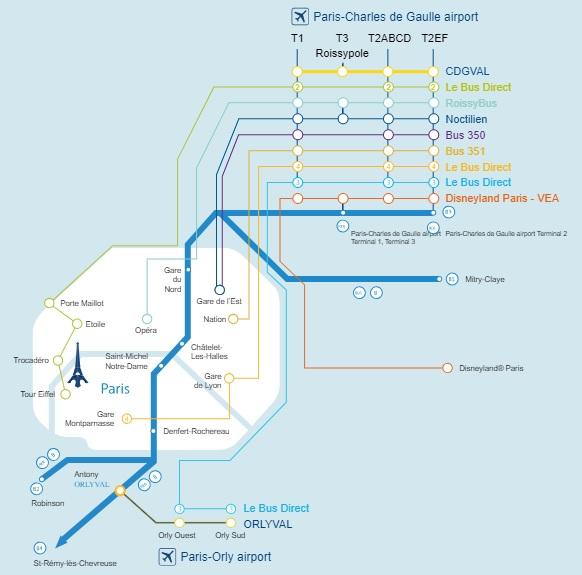
- When arriving by train, the main station in Paris is Gare du Nord, where most international services can be found travelling from Europe. It is possible to travel from Amsterdam, Brussels, Cologne and London direct to Paris Gare du Nord. When you arrive you have multiple connections possible to link up with the RER B (airport line) D and E lines, Metro 2,4 and 5 lines as well as local busses. There is also information points, travel tours and police station at hand.
✔️Tip: If you are staying in Paris 3, 4 or up to 7 days then consider buying the weekly pass "Navigo". This electronic system is the Paris integrated card for easy access for all modes of transport within the Paris region and zones. It's also valid to take from the airports, Disneyland and other outskirt areas. One week costs €22.80, plus a €5 card fee. This is much cheaper than buying the RER twice, plus metro or bus rides individually. For more info on the Navigo card click on this link.
Paris offers to the visitor an unlimited number of cultural, historical, artistic and entertainment options! There are dozens of places to visit and monuments to see. It's recommended that you plan a little your visit as not to miss what is important to you. Paris is one of the cities with the greatest diversity of museums in the world! One hundred or so Parisian museums showcase paintings, sculpture, photography, contemporary art, science and collections on a whole range of subjects. There is so much to see! You can also visit the famous Chateaux (palaces), relax in the many parks and gardens and if you are not tired yet, in the evening enjoy the many gastronomic offerings in the city as well as watching a cabaret at the famous Moulin Rouge! To help you choose and not miss out on some of the best spots in Paris we have put an essential list of places to visit during your stay. However for a more in depth description of more things to see, museums and places of interest in Paris, you can visit Parisinfo.com.
✔️Tip: If you are visiting during the low season, (1st November to 31st March). every first Sunday of the month, many of Paris official buildings, landmarks, some palaces and museums are free of charge! Check below for more details!
- La Tour Eiffel: The most iconic monument in Paris, and one of the most renowned architectural wonders of the world ever built! A not-to-be-missed monument and symbol of the capital, the Eiffel Tower stands 324 m tall, and weighs 10,100 tons. Created in 2 years, 2 months and 5 days, it was built for the Exposition Universelle of 1889.
You can go up the Eiffel Tower by the stairs or by lift. (see table). On the completely refurbished 1st floor, you can find a few shops. The 2nd floor is the main viewing platform where to admire the great views of Paris! You will also find souvenir shops, and if you can afford it, treat yourself to a gastronomic meal at the famous Jules Verne restaurant, 125 metres above ground! Finally on the 3rd floor is the summit, where you have a bird view of Paris at 360°! Booking: online on www.tour-eiffel.fr . Closest metro station is École Militaire (line 8) and Trocadero. (line 6&9)
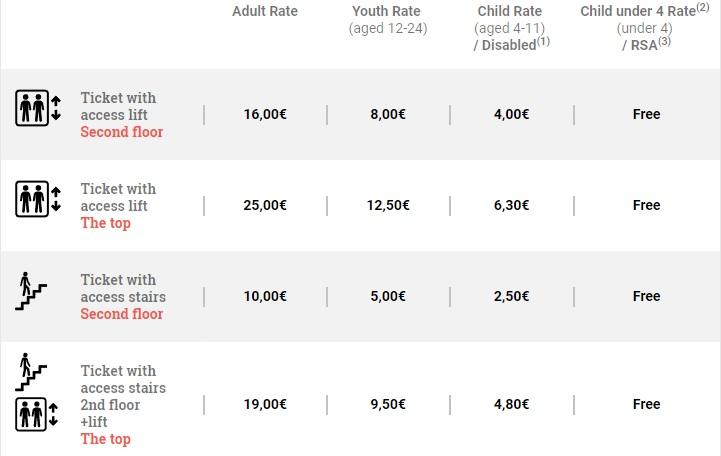
✔️Tip: Book in advance online to ensure the best times and avoid queues for tickets at the entrance. However the Eiffel Tower has lengthy times to pass the several security inspections. Arrive 30 min before your booked ticket time, specially at weekends, high season and if going up by lift.
- Notre-Dame de Paris: (closed at present due to a fire burning the roof of the Notre Dam in April 2019). A masterpiece of Gothic architecture, is one of the most visited monument in France. It was built in the Middle Ages, at the far end of the Île de la Cité. Work started in the 13th century and finished in the 15th century. Badly damaged during the French Revolution, the cathedral was restored in the 19th century by the architect Viollet-le-Duc. In 2013, Notre-Dame is celebrated its 850th anniversary. For this occasion, many events were organized and the cathedral renewed its bells with the arrival of eight new bells as well as a new great bell. Road distances from Paris in France are calculated from point 0 on the cathedral forecourt. At the top of 422 steps inside the towers of Notre-Dame cathedral, visitors are rewarded with one of the most stunning panoramic views of Paris. Before you climb up, the tour is marked by three not-to-be-missed stops: upstairs has amazing gothic architecture and vaulted warheads; the chimera galleries allow you to get close to the famous gargoyles, including the famous Stryge; and a few steps from the top, stop and admire the belfry, church bells and the famous 13-tonne Emmanuel great bell.
✔️Tip: To visit the main building is free, only at ground level. But if you want to go up remember to book your time slot online to visit the Notre-Dame Tours or on the mobile application "Jefile" (available free on Google-play or Appstore).Please note: These slots are subject to availability.If you don't have access to a smartphone, it is advised that you arrive at Notre-Dame when it opens to make your reservation on a terminal there. Entry cost is €10 per adult. Free entry first Sunday of each month, from November to March.Free for under 18 years old and residents in the EU between 18 and 25 years old. Closest Metro station: Cité (line 4).
.jpg)
.jpg)
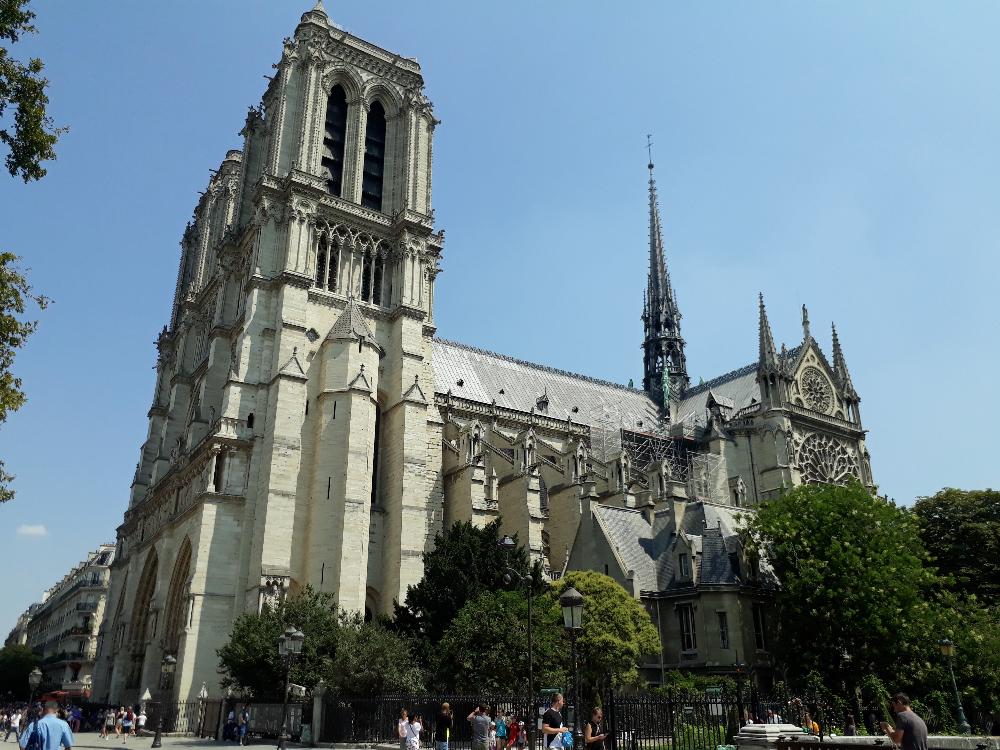
- The Grand Palais: is one of the most iconic Parisian monuments. Built for the 1900 Exposition Universelle, it is recognizable by its large glass dome flanked by the French flag. This architectural masterpiece of stone, steel and glass has been listed as a historical monument since 2000. It comprises 3 major sites: the Nave, the National Galleries and the Palais de la Découverte. The majestic nave, 240 m long, welcomes a wide variety of major national and international events: (horse riding, contemporary art, fairground, etc.). The national galleries organize large-scale exhibitions on artists that have marked the history of art (Picasso, Hopper, Renoir, etc.). The Palais de la Découverte is a museum and cultural centre dedicated to science, where children can learn whilst having fun, through permanent collections and temporary exhibtions. A 3-in-1 site that's not to be missed, close to the Champs-Elysées (see below). The monument is free to visit and only charges depending on what event is held inside the main nave. Closest Metro station is Champs-Élysées - Clemenceau (line 1 and 13).
- Av. des Champs-Elysées: Frequently described as ‘the world’s most beautiful avenue’, the Avenue des Champs-Élysées is a Paris must-see.This iconic two-kilometre stretches between the Place de la Concorde and the Arc de Triomphe. Like the Eiffel Tower, the avenue is a symbol of Paris. It is lined with restaurants (l’Atelier Renault, Ledoyen etc.), luxury boutiques (Louis Vuitton, Mont-Blanc, Guerlain, Ferrari etc.), flagship stores (Banana Republic, Abercrombie, Sephora etc.) and nightclubs. It is also the setting each year for major events such as the Bastille Day military parade, the arrival of the Tour de France and the Christmas lights. Finally, the Avenue des Champs-Elysées has some of the top museums in Paris: the Grand Palais, the Petit Palais, the Palais de la Découverte and the Espace Culturel Louis Vuitton. The best view of the Champs-Elysées avenue is by climbing all the way to the top of the Arc de Triomphe for a spectacular view of Paris! (see below). Closest Metro station Concorde (line 1,8,12), Champs-Élysées - Clemenceau (line 1 and 13), Franklin D. Roosevelt (line 1 and 9) and George V (line 1).
- Arc-de-Triomphe: Situated at the Place de l’Etoile, overlooking the Champs-Elysées, the Arc de Triomphe is the biggest arch in the world. It was commissioned by Napoleon in 1806 to celebrate his victory at Austerlitz. The architects Chalgrin, Joust and Blouet all worked on the monument. Sculptures were designed by Cortot, Rude, Etex, Pradier and Lemaire. Beneath the arch is the Tomb of the Unknown Soldier, and each evening at 6:30pm its flame is rekindled. From the top of the monument, visitors benefit from a panoramic view of Paris, during the day and at night, and two viewpoint indicators. A museum retracing the history of the Arc de Triomphe, situated within the structure, completes the visit. Prices are €12 per adult. It's free every first Sunday of the month in the low season only. (1st November to 31st March). Closest metro station is George V (line 1).
- Place de la Concorde: is situated at the end of the Champs-Elysées. Today it is famous for the Luxor Obelisk (a 3,300 year old Egyptian obelisk erected on the square in October 1836), the surrounding prestigious hotels, and the two monumental fountains (Fontaine des Mers and Fontaine des Fleuves). Created in 1772, Place de la Concorde was originally known for having been an execution site during the French Revolution. Louis XVI and Marie-Antoinette (among others) were guillotined here. Between 1836 and 1846 the architect Jacques-Ignace Hittorf redesigned the square to become what it is today. Closest Metro station is Concorde (line 1,8,12).
- Musée-du-Louvre: The best and most important museum in Paris. It is a must see whilst in Paris to discover the wealth of treasures it contains. The museum houses western works of art dating from the Middle Ages to 1848, in addition to collections of ancient oriental, Egyptian, Greek, Etruscan and Roman civilizations, as well as graphic and Islamic arts. From room to room, the former royal palace reveals its masterpieces to the public: the Mona Lisa, The Raft of the Medusa, the Venus de Milo, and The Winged Victory of Samothrace. In total, there are 35,000 works to be discovered or re-discovered! With its eight hundred year old history, the Louvre has been influenced by numerous architectural trends, from the medieval fortress of the 12th century to the glass pyramid by Pei (1989). The latest addition, housing the Islamic arts section, was designed by architects Mario Bellini and Rudy Ricciotti. The undulating glass canopy covers the Visconti courtyard, flooding the 2,800 m² new wing with light. A visit to the museum is particularly pleasant at night: the Louvre is less crowded and visitors can enjoy stunning night-time views of Pei’s glass pyramid, the Cour Carrée and the Seine. The museum opens from 9am to 5.45pm except on Wednesdays and Fridays till 9.45pm. (Tuesday's the Museum is closed). Tickets cost €17. Closest Metro station Louvre–Rivoli(line 1).
✔️Tip: The museum is free every first Sunday of the month in the low season only. (1st November to 31st March). It is advised that you buy your tickets online, as they work per slot time. Buy your tickets here via the official page. Also arrive 30-45 min before your planned visit, security checks, build up many queues.
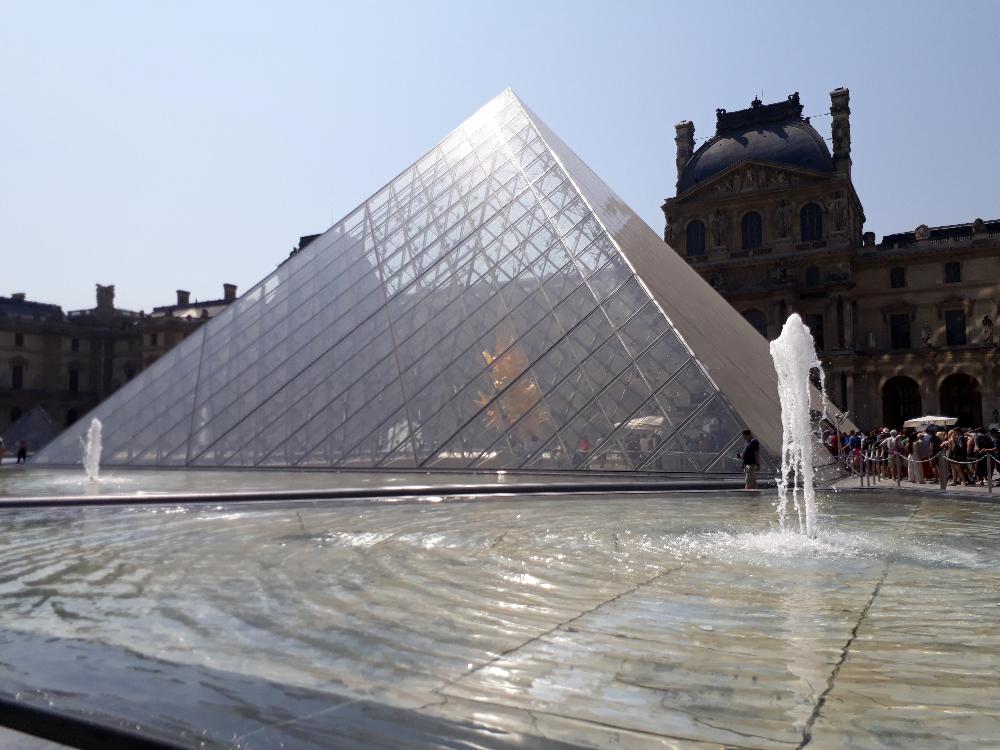
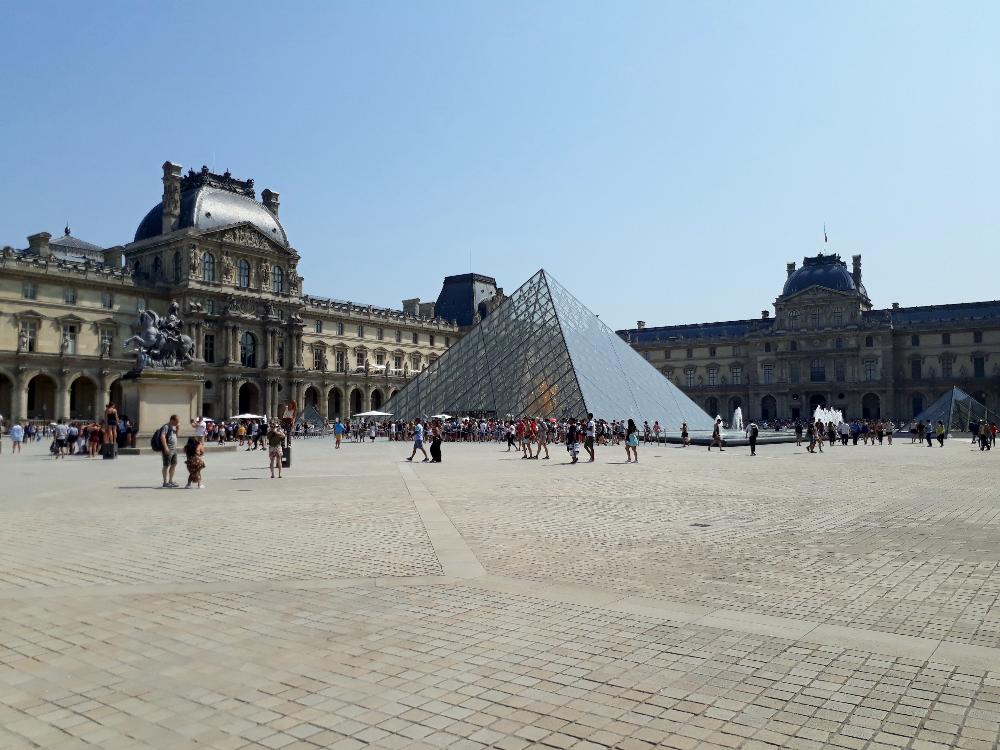
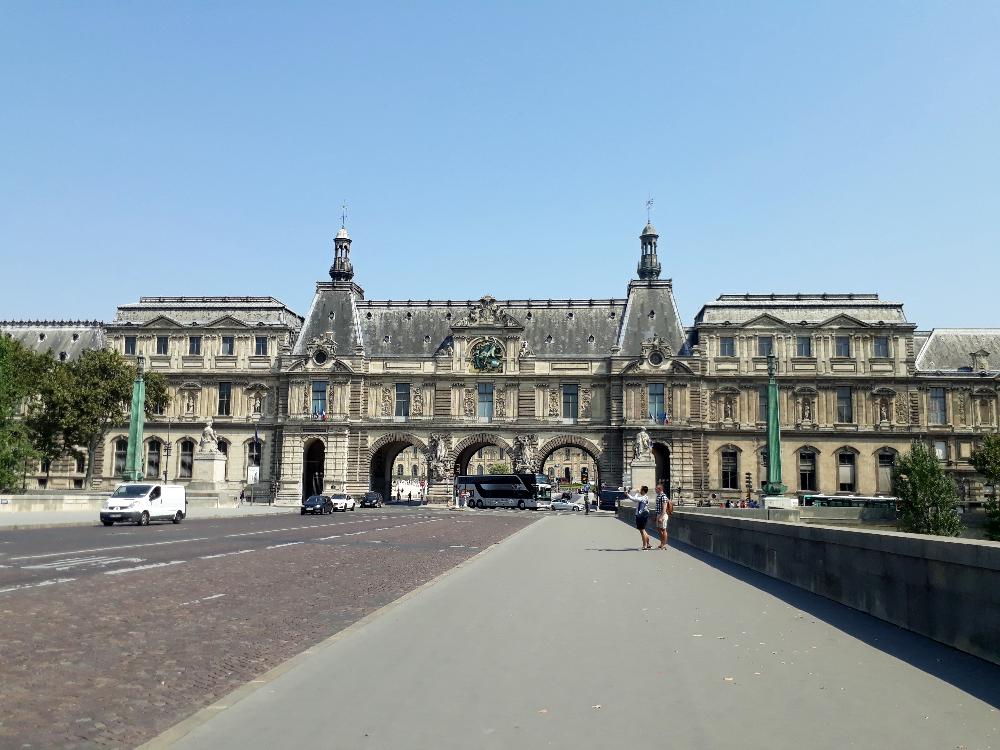
- Basilique-du-Sacré-Coeur-de-Montmartre: The Sacré-Coeur, consecrated in 1919, is one of the most iconic religious monuments in Paris. At the top of the Butte Montmarte, it has one of the most beautiful panoramic views of the capital, from 130 metres above ground. In a Roman-Byzantine style, the Sacré Coeur is recognizable by its white colour. Inside the building, the ceiling is decorated with the largest mosaic in France measuring about 480 m². The crypt is also worth a visit. And to go even higher up, visitors can access the dome where the 360° view of Paris is magnificent. A short walk from the Sacré Coeur is the Place du Tertre, the district of Abbesses with its steep, winding roads, and at the bottom of the hill, the famous Moulin Rouge cabaret. Entry to the basilica is free for all visitors. Closest Metro station is Anvers (line2).
- Moulin-Rouge: It is the most famous cabaret in the world! The Moulin Rouge was immortalised by Toulouse-Lautrec and was the cradle of the music hall with the famous Mistinguett. Since it opened in 1889, it has dazzled the whole world. Edith Piaf, Liza Minnelli, Frank Sinatra and Elton John … numerous French and international personalities have over the years become enamoured of this legendary cabaret! The room is magnificently decorated in belle époque style and red velvet, with typical burlesque frescoes. A wonderful place to enjoy gourmet French food by the Maison Dalloyau, served with champagne - the official drink of the cabaret. All your senses are awakened as you enjoy your food and watch the show! Admire a troupe of 60 artists from all over the world who perform twice each evening in the revue 'Féerie', a show made up of four breathtaking acts: feathers, rhinestones, sequins, sparkling decor, acrobats, original music, international attractions ... not forgetting the famous fast-paced French Cancan. An iconic place, flamboyant colour, talented artists, renowned craftsmen, a high quality team, original stage productions ... The Moulin Rouge is all that, and more! (Correct clothing required. Jacket and tie is appreciated. Shorts, bermudas, sports clothes and shoes, flip-flops are not allowed). Closest Metro station: Blanche (line 2).
- Château de Versailles: The Palace of Versailles, is open throughout the year and offer Parisians and visitors the opportunity to travel through the history of France and discover the treasures of cultural heritage in the Paris region. It's an unmissable visit as important even as the Eiffel Tower! The palace itself was the former hunting lodge of Louis XIII, it became the seat of French government in the 18th century. From the time of Louis XIV to the French Revolution, the Palace underwent many refurbishments, carried out by the three subsequent kings. The splendid Palace gardens, a masterpiece of landscaped design by the king’s landscape gardener André Le Nôtre, the Hall of Mirrors with its 357 mirrors, the Grand Trianon and its little rose-pink palace, and the King’s State Apartments are not to be missed on a visit to this renowned historical site, which was given Unesco status 30 years ago. Also note, in summer many special events are held in the grounds of the Palace: the Musical Fountains Show (from April to October) and the Fountains Night Show (from June to September). For these two major events, expect to see an amazing setting and show!
Getting to the Palace is easy by public transport. Take the RER trains line C to Gare de Versailles Château Rive Gauche, and walk to the palace in just 5 min. General entry to the Palace costs €20 per adult, for the Palace and Gardens. However if you wish to combine the Fountain Show, Night Show, or spread your visit into two days there are also multiple tickets available. Check which tickets you wish to purchase from this link to the official website.
✔️Tip: Remember that the Park of the Palace is free to visit, this also gives a great view of the Palace. So if you are on a budget it is still possible to enjoy some great views and it's a very pleasant walk around the park. Note that the Palace and Gardens are free every first Sunday of the month in the low season only. (1st November to 31st March).
- Musée-d'Orsay: Internationally renowned for its rich collection of Impressionist art, the Musée d'Orsay also displays all Western artistic creation from 1848 to 1914. Its collections represent all expressive forms, from painting to architecture, as well as sculpture, the decorative arts and photography. You're sure to be dazzled by the beauty of the place: a train station that looks like a palace, inaugurated for the 1900 Universal Exposition. At the end of 2011, the museum reopened all of its entirely renovated spaces as well as some new rooms: an additional 400 m² for the Pavillon Amont. Ticket entrance is €14 per adult. It's free every first Sunday of the month in the low season only. (1st November to 31st March). Closest Metro station is Solférino (line 12) or Gare Musée d'Orsay (RER C).
- The Centre Pompidou: designed by Renzo Piano and Richard Rogers, is a 20th-century architectural marvel, immediately recognizable by its exterior escalators and enormous coloured tubing. It is home to the National Museum of Modern Art and is internationally renowned for its 20th and 21st century art collections. The works of iconic artists are displayed chronologically over two sections: the modern period, from 1905 to 1960 (Matisse, Picasso, Dubuffet, etc.), and the contemporary period, from 1960 to the present day (Andy Warhol, Niki de Saint Phalle, Anish Kapoor, etc.). In addition to its permanent collections, internationally renowned exhibitions are organized every year on the top floor, where visitors can enjoy a breathtaking view of Paris and its rooftops. Ticket entrance is €14 for the museum plus rooftop or €5 for the rooftop access only. It is free every Sunday of the month. Closed on tuesdays. Closest Metro station is Rambuteau (line 11).
- Musée de l'Orangerie: In impressively-sized rooms, this museum houses a series of large Water Lilies paintings which are masterpieces offered by Monet himself to France in 1922. The basement houses the Jean Walter and Paul Guillaume collections which are dedicated to the great names of the 20th century: Renoir, Cezanne, Matisse, Picasso, Soutine etc. Entrance fee is €9, except the first Sunday of every month. Closest Metro station is Concorde (line 1,8,12).
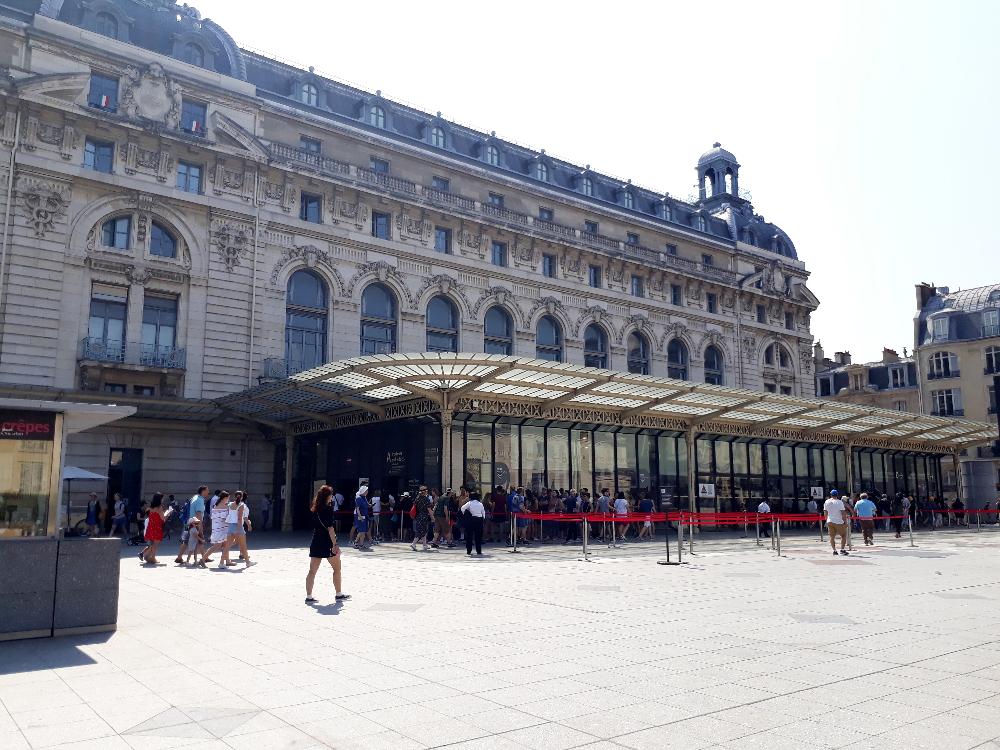
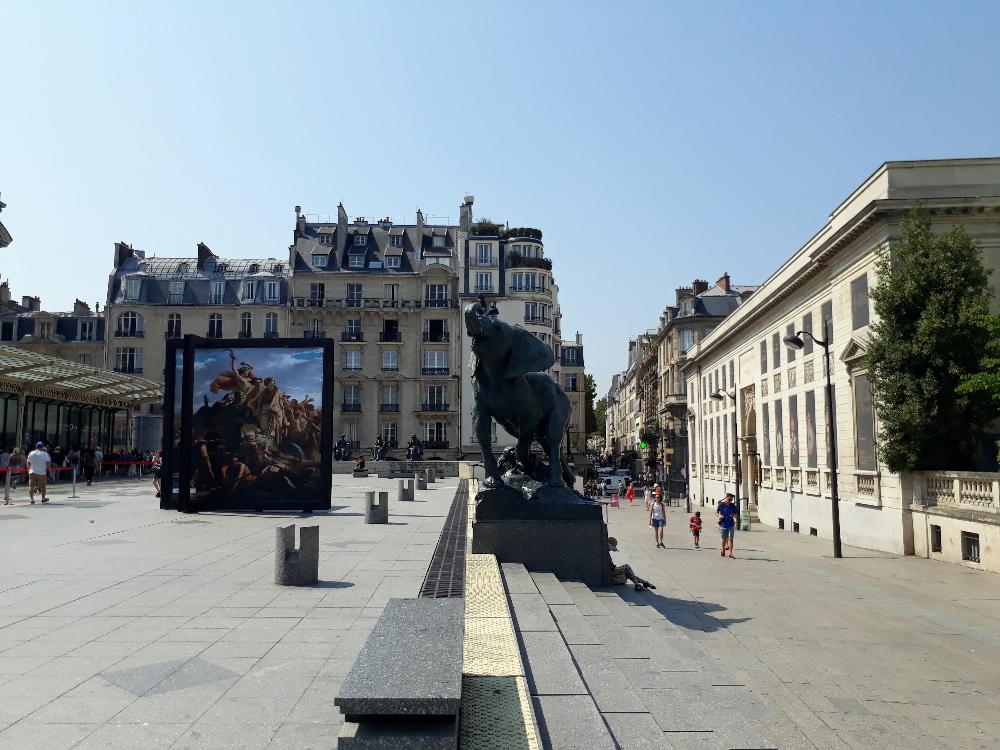
- Park and Gardens Bois-de-Boulogne: A former hunting ground for the Kings of France, the Bois de Boulogne has become the largest spot for relaxation in the west of Paris. With a surface area of 850 hectares, one of the ‘lungs’ of the capital encompasses the Parc de Bagatelle, the Jardin des Serres d'Auteuil, the Pré-Catelan and the Jardin d'Acclimatation. It offers numerous walkways, 28 km of bridleways and 15 km of touristic cycle routes. There are numerous facilities, which have been designed to suit everyone, such as playgrounds for children, the Musée en Herbe, picnic areas, bicycle hire and boat hire on the Lac Inférieur, the Auteuil and Longchamp racecourses, restaurants and the Théâtre de Verdure. When you need some open space to disconnect from the city noises, relax, unwind and get close to nature this park is what you are looking for! Closest Metro station Neuilly Porte Maillot (line 1 or RER C), Gare Avenue Foch (RER C) Porte Dauphine / Maréchal de Lattre de Tassigny (line 2), Gare d'Avenue Henri Martin (RER C), Porte d'Auteuil (line 10) or Les Sablons (line 1).
World famous by it's castles, princess stories and Mickey Mouse and friends characters this entertainment park is one like no other! With 2 Disney parks®, more than 50 attractions, shows and parades, Disneyland® Paris promises a unique day with friends or family. Suitable for all ages, whether you are a Disney fan or not, this park definitely has the magic factor and staying till the end is well worth it to see the final firework display at 23h to mark the best ending to your adventure day!
The Park offers 5 themed worlds, the Parc Disneyland® is a dream place for kids as well for big kids on the lookout for magic and lots of fun! Feel the adrenaline exploring the far reaches of space or the remains of an abandoned temple whilst you meet with your favourite Disney characters to take pictures and engage with them!
Next door, the Walt Disney Studios Park® offers many adventures and thrills: defy gravity in a plummeting elevator, live a 100% Rock 'n' Roll adventure with bends and looping or enjoy Remy's mad adventure! The shows and parades run from opening until well into the night! Entrance tickets are expensive and unfortunately few or non two for one vouchers are available unlike other types of parks. In order to get a cheaper ticket always buy online in advance via an authorised retailer for Disneyland® or the official site: Disneylandparis.com. Prices are generally around €65-70 for one day pass with access to the two parks or you can get a two day pass for €130.
Getting to Disneyland® is easy from central Paris thanks to a direct rail line, take the RER A (A4 branch) line to Marne-la-Vallée - Chessy Disneyland® Park, the trip takes around 45 minutes. Note the last trains to come back leave at 00.10am back for central Paris.
✔️Tip: When planning your visit to the park it's recommended you arrive as the park opens to take advantage of the "fast pass" which allows you to reserve a specific time on many of the attractions and rides. The park is always busy with many tourists and visitors especially during the weekends and the Summer holidays where long queues must be expected, sometimes hours. Arriving early will also guarantee you see as much as possible and enjoy the shows, meet the Disney characters and spend the most between the two parks. Although note that the parks are quite big and riding all rides and seeing all shows is really hard in one day, if not impossible, so planning is essential.
When you arrive take a map and plan your times according to your preferences and make sure you are near to the castle around 22.30 to take a good place to watch the fireworks-music and light display to end the adventure! Enjoy!
Paris's nightlife has a reputation extending back for hundreds of years. While most tourists won't venture beyond the crowded and overpriced bars of the Champs Elysées, there are many bustling nightlife districts in Paris worth exploring.
Bastille has a mixture of noisy nightclubs and bars best suited to twenty-somethings. Oberkampf was the place to be in the 1990s, and still buzzes with hipster-filled cafes.
The area around the Louvre is home to some of the most upmarket, and expensive, bars in Paris, including the Ritz's Hemingway Bar in Place Vendome, a piano bar frequented by the writer in the 1940s.
Montmartre is the home of the famous (or infamous) Moulin Rouge cabaret, which still presents glittering extravaganzas on a nightly basis, though the price tag is a bit higher than when it started in 1889. Nearby Pigalle is a bit seedy, but offers some good rock music venues. Marais also boasts a good selection of bars and cafes, with a thriving gay and lesbian scene.
There is no end to the live music possibilities in Paris. Nouveau Casino hosts a variety of bands on most nights, and La Flèche d'Or is known as an indie-rock venue. Belleville's La Java hosts an eclectic mix of artists in the venue where Edith Piaf debuted.
For a more sedate music experience, the Cité de la Musique hosts classical, jazz and traditional concerts in a network of concert halls. Paris is of course an opera paradise. You'll find symphonies and operas at the Opéra Bastille, lighter opera at the Opéra Comique, and you might even spot the phantom of the opera at the grand Opéra Garnier, the home of the Ballet de l'Opera National de Paris.
Paris is a shopper's paradise. Those after luxury goods will feel at home with the famous names of the high-end boutiques found on Rue du Faubourg Saint-Honoré such as Dior, Chanel, Givenchy, and Jean-Paul Gaultier. Trend-setting fashions can be found in Rue Etienne Marcel shops. Sadly, the Champs-Elysées is not what it used to be, with banks, fast-food chains and malls strategically placed to trap tourists. However, some good stores remain - perfume from Guerlain Parfumerie is a classic Paris souvenir.
Galeries Lafayette is a famous French department store. The flagship store is located on Boulevard Haussmann and has been a Paris icon since its creation in 1894. Beneath the decorative Art Nouveau dome lies 65,000 square metres of floor space hosting more than 3,500 brands from around the world. The energy, architecture, layout, restaurants and views over the city have turned Galeries Lafayette into a prime tourist attraction for shoppers and browsers alike.
Les Halles is a subterranean shopping mall with more than 150 stores where bargain hunters will be able to find cheap knockoffs and other trendy clothes. Mainstream department stores offer some great finds, such as La Samaritaine, which prides itself as being the one where on trouve tout (one finds everything). Just outside the city, La Vallée Village offers designer goods at steep discounts.
Bargains closer to town can be sniffed out in abundance at the three main flea markets situated around the old gates of the city. They are, however, teeming with pickpockets and shoppers should be on their guard. Les Bouquinistes, which consists of rows of bookstalls perched against the walls of the Seine River, is a great place for bookworms to browse and barter.
Those determined to buy a plastic Eiffel Tower or other tacky souvenir, will find tourist tat plentiful along rue de Rivoli. Those looking for something a bit different to take home should visit the La Plaque Emaillées in Filles-du-Calvaire for a taste of turn-of-the-century Parisian Art Nouveau.
Finding reasonable hotels in Paris is very difficult since the city is known for its popularity with travellers, business and fashion which push prices always up. When staying in Paris it's advised to look for hotels away from the city centre, with easy access by metro or night busses.
Anything which is outside from the inner city, (see image with blue perimeter) will be substantially cheaper when on a budget. Alternatively choose to stay close to an RER line where trains are quick into the city and you can save on nightly rates. In general central Hotels in Paris can be as expensive as €150-300 per night but it's possible to find also hotels at €50-70 if you go down in stars. If you are on a tight budget, then Hostels can cost around €15-20 for shared accommodation in central Paris. Airbnb is also a popular option to stay with local people or cheaper when you stay for longer periods of time.
A recommended Hotel chain in Paris, is Ibis budget. There are a few dotted around the city which gives you good choice where to stay. Prices are reasonable, at €40 per night, with private bathroom and 24h reception. There is one at Porte de Montreuil, west Paris, easy access to metro (5 min walk), next to a shopping centre, supermarket and shops nearby, also good if visiting Disneyland.
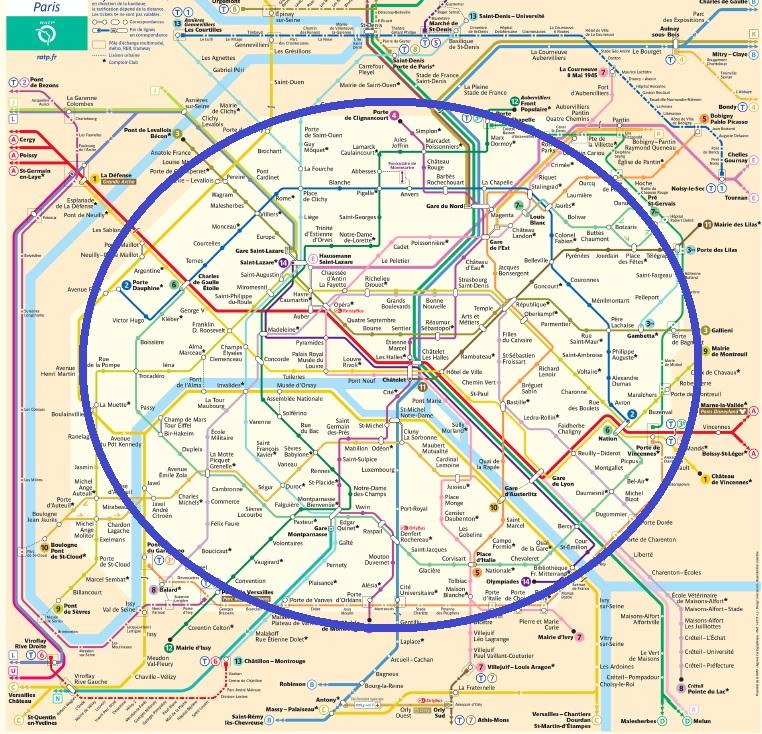
For a first time visitor to Paris, you will be amazed of the amount of things to see and do in the city. It takes time to visit so many attractions, sights and museums therefore coming to Paris is not a quick affair! Planning your visit is recommended to maximise your time but if you are on a tight budget and want to see only the most important sights and monuments, then 2 or 3 nights would be ideal. Avoiding the weekends and high seasons (summer time July/August, Christmas or Easter Holidays) is also advised to miss the long queues which build up to get into everywhere. Although Paris is now subject to much more security, so expect to queue which ever the time of year. For a complete visit of Paris, including some Palaces, parks or gardens, time for shopping and watching a cabaret show at Moulin Rouge give yourself a week to comfortably fit it all in!

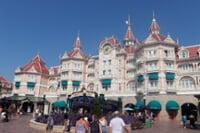
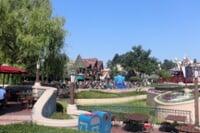
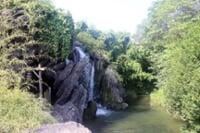
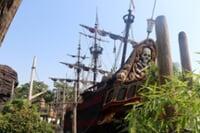
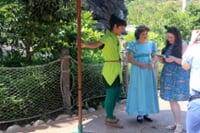

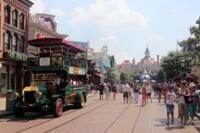
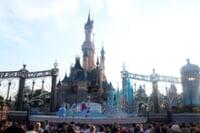
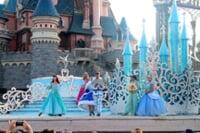
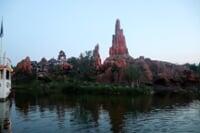
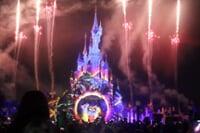
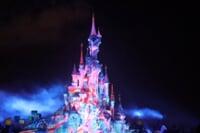
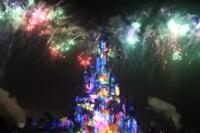
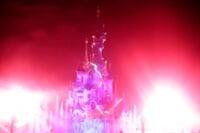
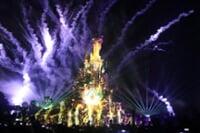















.png)